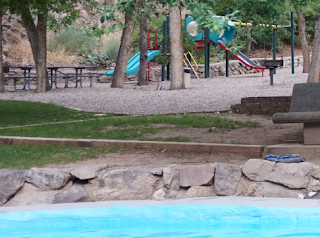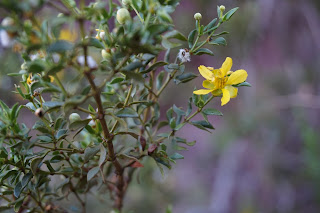Part of the fun of moving here has been immersing myself in a whole culture that I'd pretty much actively avoided before. Yeah, this is cowboy-a-go-go-land (hat tip to Louise Rennison), it's the Wild West. Nevada still fancies itself as a frontier state, and it shows all over the place. Bless.
If I need to learn a thing, I'm all 'is there a book about that'? So, I wanted to read the stories to try and connect with this place and understand it. Here, therefore, are two books of Western stories.
The thread that pulls all these stories together is the gunfight. The author takes us lovingly through the whole showdown - the buildup, the endless split second and the thunder of shots, the fall into dust. He unpacks the fights with forensic care - a wound on the back of the hand tells all participants this guy was roundly beaten - his opponent reached, drew and shot while the other guy was still flailing round with his holster. (Most stories have fist fights too. I have to admit I find detailed descriptions of fist fights both tedious and distressing, and the details rarely turn out to matter, so I usually skim those. Hope I'm not missing any delicate gradations there.)
So that's - awesome? Who reached first, who drew first, I guess when I get round to watching who shot first (er, Star Wars or whatever) it will be so much more richly nuanced?
In fact, the whole book is shaped like a series of gunfights, rapidfire, an ever-drifting, ever-changing cast of characters who mosey into Main Street, draw, shoot, and either fall or walk away into the endless dust. Having said that, I did enjoy it. The good guy generally wins, often getting the girl into the bargain. But the characters are not all the same, the situations likewise, and anyway the real star is the Southwest itself.

The peculiar affordances of desert and chapparal constrain the characters' actions in ways both plausible and interesting. The proverbial harshness of the arid lands becomes a plot element where self-indulgence or self-restraint play out in larger consequences, as in the desperately dried out man who has been walking through the desert, and shows his character almost from the moment we meet him by closing the gate behind himself, but even more, by having the discipline not to take more than a sip of water at first. This foreshadows blah blah ... Okay, it's a bit formulaic, but it's pretty well done. It was not surprising to learn that the author did work and travel widely in the southwest.
(An interesting note to this specific edition, too. Just as water rights are everything for farming in the SW, in the twentieth century, copyright has been everything to authors. The introduction has an extraordinary more-in-sorrow-than-in-my-justifiable-outrage compliment to the reader on purchasing the authorised edition, and not some other publisher's edition that was perfectly legal but not profitable for the author - I think these stories are reprints that originally appeared in magazines. There's an exhortation to only buy the authorised editions, and a carrot in the form of special author selections, introductions, and extra stories. There's also a sales spread, not unlike Reader's Digest, in the middle of the paperback edition, inviting the discerning reader to purchase a fancy hardback set. Guessing our grandkids will find print copyright as much of a historical footnote as Pa Ingalls
proving a homestead.)

Compared with this, 'Riding for the Brand' is "
as moonlight unto sunlight, and as water unto wine." In fairness to Mr L'Amour, I have to admit a personal fondness for White's rich vocabulary and the rolling gait of his paragraphs. Here, too, stories are strung onto a broader narrative of cattle-raising in turn-of-the-century Arizona. This is a less uninteresting topic to me than gunfighting per se.
Told from the point of view of one of the cow-hands (a man as nearly invisible in his own tale as
Bella Swan in hers), the stories are more varied, both in kind and in structure. There are tall tales, comic tales (some tales both tall and comic), tales of love, revenge, greed - just about everything except religion. And just as 'Riding for the Brand' is shaped like a gunfight, 'Arizona Nights' is shaped like a round-up; a loose line far out on the plain, little bands of cattle going every which way, gradually drawn into one tight herd by careful craft and a lot of effort. The book increasingly focuses on the ranch owner, and the later chapters tell a strange and moving love story. (No spoilers, because if you're going to read either of these books, I'd say read this one, and it's an unusual tale that deserves to be encountered fresh.)
The lovely and varied scenery of Arizona is a setting here, not a plot device. The narrator and the author seem equally charmed by the wide land, the clear light, the astounding expansions and contractions of distance. The story takes us through deserts, mountains, and chapparal, in all seasons. The descriptions sometimes verge on the rhapsodic (I say this affectionately, as anyone who reads my stuff for any length of time knows it's a failing of mine, too). But I have the sense that the land is there and the story takes place within it, whereas in 'Riding for the Brand' I often had the sense that the land was somehow elastic, conjured into being to provide the needed cave, spring, rocky defile, or small-town street that would make the story work correctly.
But I think that what I most loved about this, and what moved me, is that this is not some cocky fast fiddle tune about proving yourself to someone else. It's a largo for cello, on the heart-hunger that makes the huge desert distance and the finality of death touch us at the centre - and about our best innate miracle - leaving all those sandstone wonders and wide skies behind - the miracle of how we can abruptly see everything anew, in the blink of an eye.


















































